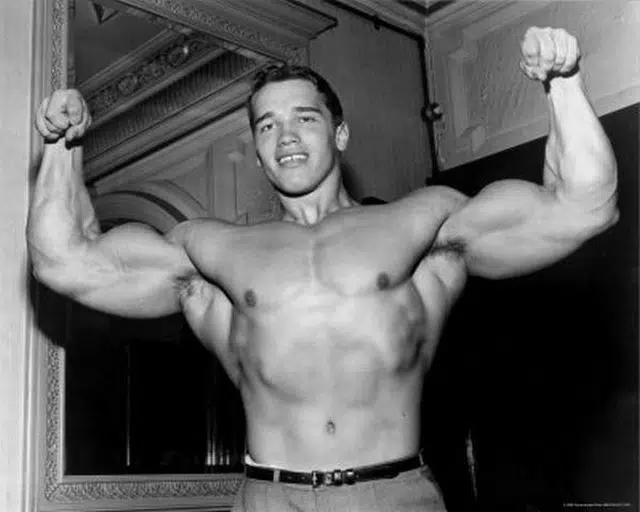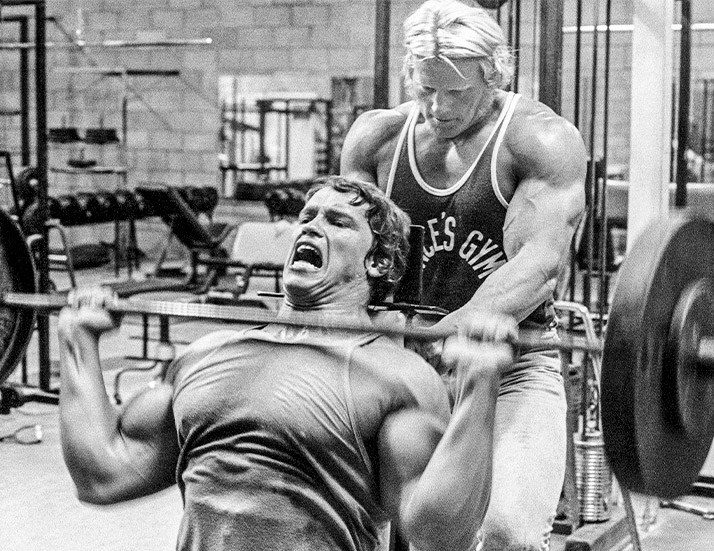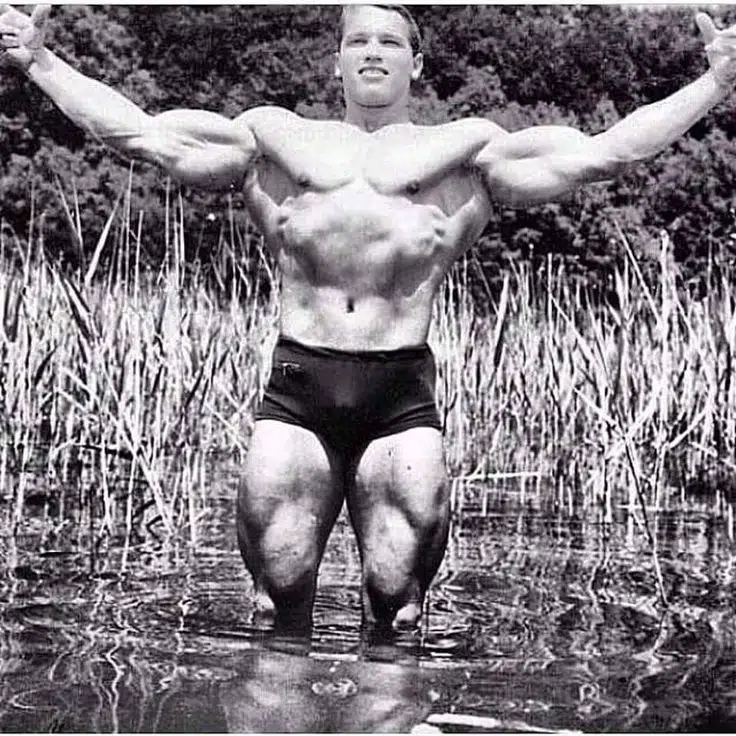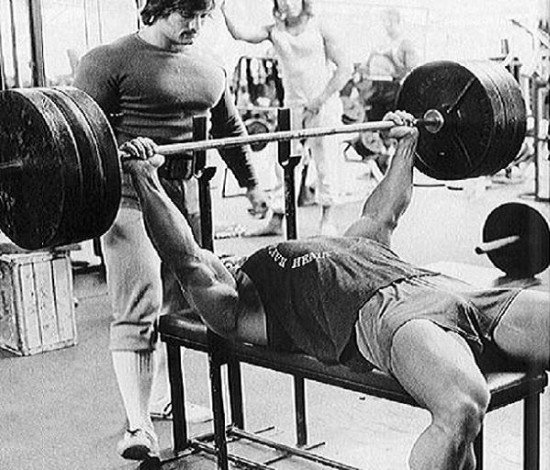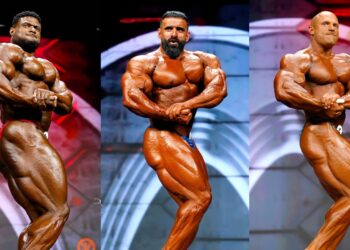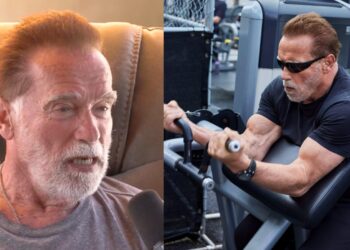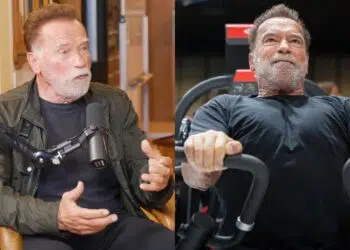Ask almost anyone to name a well-known bodybuilder, and they’ll probably say Arnold Schwarzenegger. That’s hardly surprising given the incredible impact “The Austrian Oak” has had on the sport of bodybuilding.
Not content with winning seven Mr. Olympia titles (1970, 1971, 1972, 1973, 1974, 1975, and 1980), Schwarzenegger also used his incredible physique to break into Hollywood, started his own fitness sports tournament – the Arnold Sports Festival – and authored numerous training books, including the bestseller “The New Encyclopedia of Modern Bodybuilding.”
As a veteran personal trainer, Arnold Schwarzenegger has been an inspiration since I first watched the documentary Pumping Iron back in 1977. In fact, I’d say that the training montages in this movie are what first inspired me to start lifting weights.
Based on Schwarzenegger’s books and articles, most people assume that Arnold built his body using high-volume workouts and six-session-a-week split routines. And while it’s true that he favored this approach after moving to America from Austria and turning pro, he actually started his bodybuilding journey using a full-body program called the “Golden Six.”
Full-body workouts are often labeled as ineffective or only suitable for beginners. However, as Schwarzenegger himself and numerous researchers have proven, this is not necessarily the case (1, 2).
In this article, we take a closer look at Arnold’s Golden Six, discuss its validity and effectiveness, and provide a few tips for making it even more effective.
Level Up Your Fitness: Join our 💪 strong community in Fitness Volt Newsletter. Get daily inspiration, expert-backed workouts, nutrition tips, the latest in strength sports, and the support you need to reach your goals. Subscribe for free!
Arnold’s “Golden Six” Routine
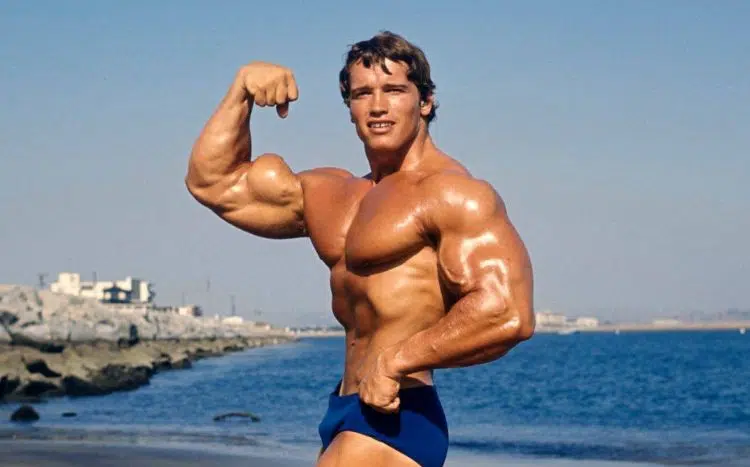
Arnold’s Golden Six routine is a classic old-school full-body workout designed to build basic mass and strength. It’s a program from Arnold’s early years and was one of his favorites before he began using split routines.
Built around six basic exercises, the Golden Six can be used before progressing to more demanding programs, as a maintenance program between periods of high-volume/high-intensity training, or simply to try a workout from the golden era of bodybuilding.
Program Overview
The Golden Six is meant to be done three times a week on non-consecutive days, e.g., Monday, Wednesday, and Friday.
It’s a mass-building program so make sure your diet supports your training and provides a suitable kilocalorie surplus. Alternatively, you could go full old-school and try the gallon of milk a day (GOMAD) diet, which is guaranteed to help you pack on mass and gain weight.
The Program
| Exercise | Reps | Sets | Recovery | |
| 1 | Squat | 10 | 4 | 2-3 minutes |
| 2 | Bench press | 10 | 3 | 60-90 seconds |
| 3 | Chin-up | AMRAP | 3 | 60-90 seconds |
| 4 | Behind-the-neck press | 10 | 4 | 60-90 seconds |
| 5 | Barbell curl | 10 | 3 | 60-90 seconds |
| 6 | Bent-knee sit-up | AMRAP | 3 | 60-90 seconds |
Arnold’s Golden Six – Pros and Cons
You only have to look at pictures of the young Arnold Schwarzenegger to see that his Golden Six routine was incredibly effective; he was a beast even before he was 20! That said, hindsight and a lifelong study of bodybuilding programs mean I’m in a great position to analyze and provide feedback on this routine.
So, is the Golden Six routine worth your time and energy? Keep reading and find out!
Pros
Built Around Effective Compound Exercises
The Golden Six routine features some of the best exercises for building strength and mass, including bench presses, squats, chin-ups, and behind-the-neck presses. As well as working numerous large muscle groups, these exercises also hit some important minor muscles, including the biceps, triceps, forearms, and core.
Compound exercises are generally more time efficient than isolation exercises, as well as more functional.
No Special Equipment Required
You don’t need a state-of-the-art gym to follow the Golden Six routine. In fact, all you really need is a barbell, bench, and squat rack. As such, Arnold’s Golden Six is ideal for home and garage gym workouts.
Proven Exercise Order
Putting exercises into a sensible order is a skill that some program writers never seem to learn. However, young Arnold figured this out way back in the 1960s, and without access to the internet! The exercises in the Golden Six routine flow nicely from largest/hardest to smallest/easiest. This ensures that you can put maximum effort into each movement.
Similar Volume for All Muscle Groups
Arnold was known for his massive chest and biceps, so it would be no surprise if his Golden Six program emphasized these muscles. However, instead, each main muscle group only gets one exercise, providing reasonably balanced workout.
Appropriate Set/Rep/Rest Scheme
Current research suggests that you can build muscle using almost any rep range – from 6 to 35+ (3). The only proviso is that you must take your sets to within a couple of reps of failure (4). However, most bodybuilders prefer to work in the 8-12 rep range.
The Golden Six uses sets of ten reps, which has proven effective for hypertrophy. Rest periods of 90 seconds are also appropriate for bodybuilding. Slightly longer rests for squats reflect how much more difficult this exercise is compared to the other movements in the program.
Manageable Volume
Comprising a total of 20 sets, the Golden Six routine should take between 60-75 minutes to complete. That’s a very manageable time for most exercisers, and 20 sets is an appropriate volume for a full-body workout.
Many workouts contain far too many sets, so they not only take too long for the average person to complete, but they are also too tiring and can lead to overtraining.
Plenty of Time Between Workouts for Rest and Recovery
While there is no denying the effectiveness of Arnold’s high-volume, high-frequency workouts, most people will struggle to recover from training for two hours per session, six times a week. Remember, Schwarzenegger was a professional athlete who was paid to train and didn’t have to balance his workouts with a full-time job.
Level Up Your Fitness: Join our 💪 strong community in Fitness Volt Newsletter. Get daily inspiration, expert-backed workouts, nutrition tips, the latest in strength sports, and the support you need to reach your goals. Subscribe for free!
The day-on/day-off Golden Six routine provides plenty of time for rest and recovery, and should slot more easily into even the busiest schedule.
Cons
Too Few Leg Exercises
Squats are often called the king of exercises, and it’s a title they deserve. Barbell squats work all your major leg muscles and are a proven strength and muscle builder. But, as good as squats are, you need more than this one exercise to build a muscular, powerful lower body.
For starters, while squats work your hamstrings, it’s your quads that are doing most of the work. Consequently, your hammies won’t receive the same growth stimulus as the muscles on the front of your thighs. Secondly, squats don’t build bigger calves.
So, while squats are an effective leg exercise, they are not perfect. Arnold’s reliance on squats might be why his leg development was lacking at the start of his career, and why he was often photographed while standing in water.
Solution: Add some direct hamstring exercises to the program, e.g., leg curls and Romanian deadlifts. Calf raises would also make an excellent addition.
No Rows for Back Thickness
While chin-ups are an effective back and biceps builder, they mostly develop wider lats rather than upper back thickness. As modern bodybuilders often say, if you want to grow, you gotta row!
Solution: Balance the chin-ups with some seated cable, bent-over, single-arm dumbbell, or T-bar rows to build a back that’s as thick as it is wide.
Behind-the-Neck Presses May Be a Problem for Some Lifters
Behind-the-neck presses have fallen out of favor in recent years. That’s because fewer and fewer people have the shoulder and thoracic spine mobility to perform them correctly. Consequently, attempting this exercise could cause shoulder pain. So, while some exercisers can do behind-the-neck presses, many cannot.
Solution: Replace behind-the-neck presses with a more shoulder-friendly exercise, such as military, dumbbell, or Arnold presses.
Bent-Leg Sit-Ups Are Not the Best Abs Exercise
As a former British Royal Marine, I’ve done thousands of sit-ups. Consequently, I’ve experienced first-hand how ineffective they are for training the abs. Sure, you’ll feel your stomach muscles working, but you’ll also feel this exercise in your hips and lower back. As this is your only abs exercise, there are better options for training your midsection.
Solution: Replace sit-ups with a higher-quality abs exercise like cable crunches, weighted planks, or hanging knee raises.
No Direct Triceps Work
Of the two main muscles that make up your upper arms, the triceps are the biggest. So, it’s somewhat odd that Arnold’s Golden Six routine does not include any direct triceps training.
Yes, the triceps are trained indirectly during bench and behind-the-neck presses, but that’s true of the biceps during chin-ups, and they still get an exercise that hits them directly – barbell curls. This imbalance could undermine the size of your arms, which is something no self-respecting bodybuilder wants!
Solution: Include a direct triceps exercise, such as skull crushers, pushdowns, or dips to give the backs of your arms as much attention as the fronts.
Maybe Too Repetitive for Some Exercisers
Arnold’s Golden Six routine involves doing the same workout three times a week for several months. While effective, some people may find this lack of variety boring, and boredom is a common excuse for skipping workouts. A more varied program would probably be more appealing, leading to more consistent workouts.
Solution: Create two additional Golden Six-style routines and do each one once per week.
For example:
| Original Golden Six | Variation #1 | Variation #2 |
| Squat | Leg press | Deadlift |
| Bench press | Incline dumbbell press | Floor press |
| Chin-up | Lat pulldown | Pull-up |
| Behind-the-neck press | Seated dumbbell press | Arnold press |
| Barbell curl | Dumbbell curl | Preacher curl |
| Bent-knee sit-up | Reverse crunch | Cable crunch |
Conclusion
Arnold’s Golden Six Routine is a classic old-school bodybuilding program. Designed to build foundational muscle and strength, this straightforward program is accessible, practical, effective, and suitable for all levels – from beginner to advanced.
Is it perfect? Probably, not but its shortcomings are easy to fix with a few minor changes, such as adding leg curls, calf raises, triceps pushdowns, and cable rows. While these adjustments will turn the Golden Six into a Golden Ten, the better training effect will make the extra training time worth it.
Or, you could try the Magnificent 7 program which, in my opinion, is one of the best ways to structure a full-body workout.
Related: I Tried Arnold Schwarzenegger’s Classic Bodybuilding Routine for 30 Days — Here’s My Transformation
References:
- Evangelista AL, Braz TV, La Scala Teixeira CV, Rica RL, Alonso AC, Barbosa WA, Reis VM, Baker JS, Schoenfeld BJ, Bocalini DS, Greve JMD. Split or full-body workout routine: which is best to increase muscle strength and hypertrophy? Einstein (Sao Paulo). 2021 Aug 30;19:eAO5781. doi: 10.31744/einstein_journal/2021AO5781. PMID: 34468591; PMCID: PMC8372753.
- Pedersen H, Fimland MS, Schoenfeld BJ, Iversen VM, Cumming KT, Jensen S, Saeterbakken AH, Andersen V. A randomized trial on the efficacy of split-body versus full-body resistance training in non-resistance trained women. BMC Sports Sci Med Rehabil. 2022 May 14;14(1):87. doi: 10.1186/s13102-022-00481-7. PMID: 35568897; PMCID: PMC9107721.
- Lasevicius T, Ugrinowitsch C, Schoenfeld BJ, Roschel H, Tavares LD, De Souza EO, Laurentino G, Tricoli V. Effects of different intensities of resistance training with equated volume load on muscle strength and hypertrophy. Eur J Sport Sci. 2018 Jul;18(6):772-780. doi: 10.1080/17461391.2018.1450898. Epub 2018 Mar 22. PMID: 29564973.
- Grgic J, Schoenfeld BJ, Orazem J, Sabol F. Effects of resistance training performed to repetition failure or non-failure on muscular strength and hypertrophy: A systematic review and meta-analysis. J Sport Health Sci. 2022 Mar;11(2):202-211. doi: 10.1016/j.jshs.2021.01.007. Epub 2021 Jan 23. PMID: 33497853; PMCID: PMC9068575.

